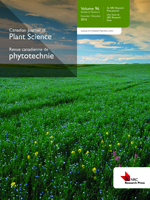Ehret, D. L., Frey, B., Forge, T., Helmer, T., Bryla, D. R. and Zebarth, B. J. 2014. Effects of nitrogen rate and application method on early production and fruit quality in highbush blueberry. Can. J. Plant Sci. 94: 1165–1179. Proper nitrogen (N) fertilizer management of highbush blueberry (Vaccinium corymbosum L.) is of major importance in south-coastal British Columbia, but little information is available. A field study was conducted to examine the effects of N rate and method of application on growth, yield, and fruit quality in highbush blueberry during the first 4 yr after planting in south-coastal BC. Nitrogen was applied at 0–150% of current production guide rates either with three equal applications of broadcast granular ammonium sulphate each spring or by fertigation through the drip irrigation system with 10 equal applications of liquid ammonium sulphate injected every 2 wk from early spring to late summer each year. Yield increased with increasing N rate during the second and third years of fruit production. The yield response as well as flower number and plant size were greater with fertigation than with broadcast fertilizers. Fruit firmness also increased consistently with increased N rates, while fruit size either increased or decreased, depending on year. There were no effects of N on fruit oxygen radical absorbance capacity (ORAC), titratable acidity, or soluble solids. However, the composition of fruit anthocyanins changed, with concentrations of seven anthocyanins decreasing, and three others increasing, with N rate. In 2 of 3 yr, total anthocyanin concentration was greater in fertigated than in broadcast treatments. Soil ammonium and nitrate concentrations increased with N rate, but only soil nitrate differed between the two application methods. Soil nitrate was higher with fertigation than with granular fertilizers, particularly at the end of the season and when greater rates of N were applied. In summary, fertigation produced more shoot growth and greater yields with less N than broadcast applications of fertilizer.
How to translate text using browser tools
20 May 2014
Effects of nitrogen rate and application method on early production and fruit quality in highbush blueberry
David L. Ehret,
Brenda Frey,
Tom Forge,
Tom Helmer,
David R. Bryla,
Bernie J. Zebarth
ACCESS THE FULL ARTICLE
It is not available for individual sale.
This article is only available to subscribers.
It is not available for individual sale.
It is not available for individual sale.
Anthocyanines
Anthocyanins
broadcast granular fertilizer
concentration d'ammonium dans le sol
concentration de nitrate dans le sol
épandage à la volee d'engrais granulaire
fertigation





